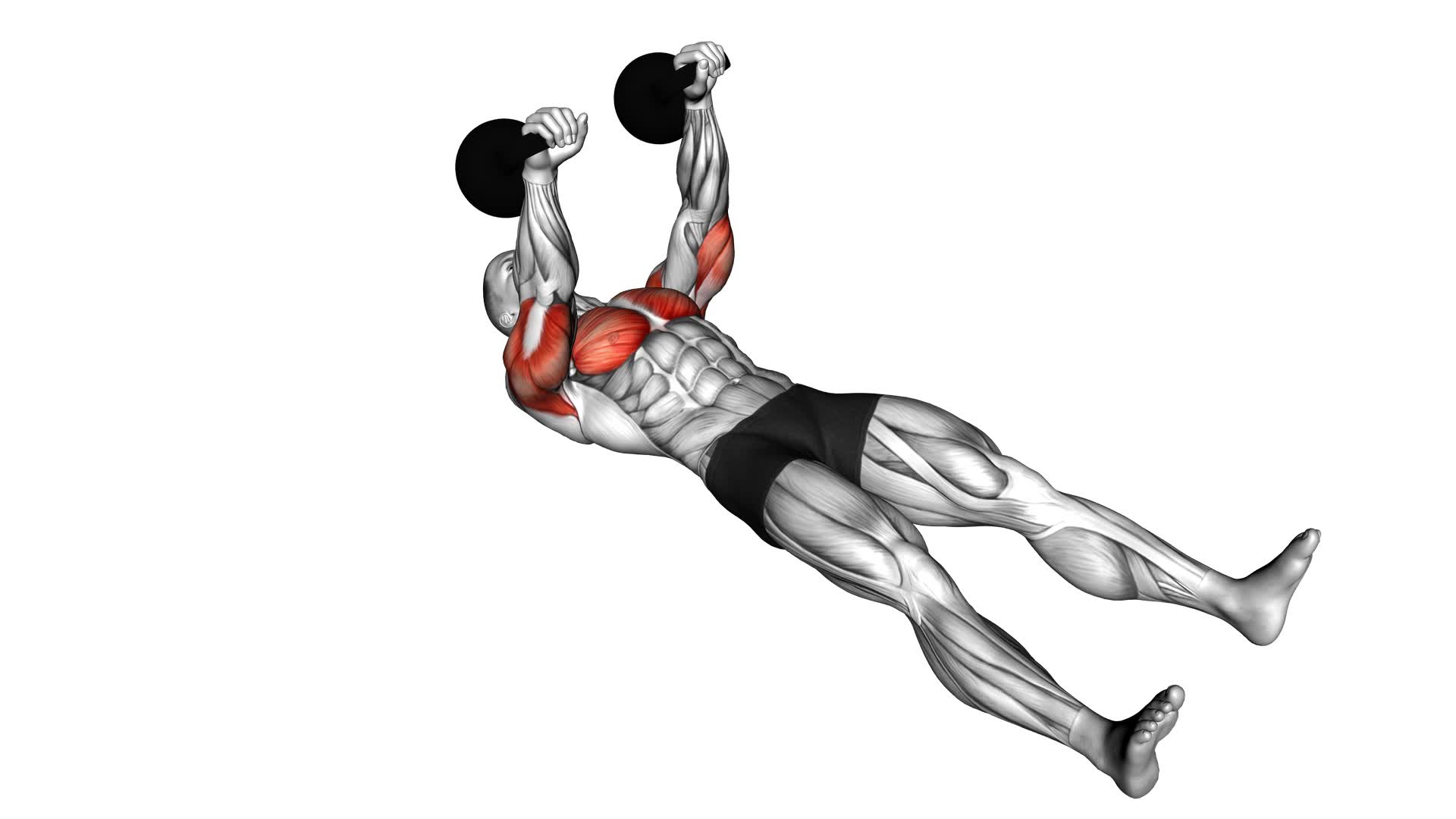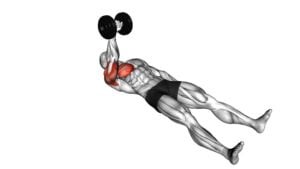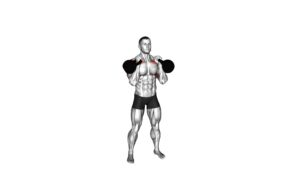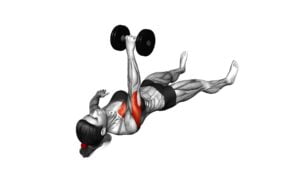Kettlebell Alternating Press on Floor – Video Exercise Guide & Tips

Are you looking for a challenging exercise to incorporate into your routine? The Kettlebell Alternating Press on the floor is a great option!
Watch This Exercise Video
This exercise targets your shoulders, core, and upper body strength. By using a kettlebell and alternating between arms, you can engage multiple muscle groups and improve your overall stability.
In this article, we provide a video exercise guide and helpful tips to ensure you perform this exercise with proper form and technique.
Let's get started!
Key Takeaways
- The Kettlebell Alternating Press targets shoulders, core, and upper body strength.
- Proper form and technique are important, starting with a lighter kettlebell and focusing on each repetition while engaging the core.
- Common mistakes to avoid include incorrect grip positioning, lacking core stability, overarching the lower back, using too much weight, and rushing through the exercise.
- Modifications and advanced variations are available, including modifications for beginners and advanced variations to challenge yourself. It is also important to listen to your body, seek professional guidance, and prioritize individual health and well-being.
Benefits of the Kettlebell Alternating Press
You can experience a wide range of benefits by incorporating the kettlebell alternating press into your workout routine. This exercise is great for shoulder strength training and will help you build strong and defined shoulders.
One of the benefits of the kettlebell alternating press is that it allows for kettlebell press variations, which helps to target different muscles in your shoulders. By alternating between presses on each side, you're able to work both the anterior and lateral deltoids, as well as the trapezius muscles.
This exercise also engages your core muscles, helping to improve stability and balance. In addition, the kettlebell alternating press promotes functional strength, as it mimics movements in daily activities. It can also help improve your posture by strengthening the muscles that support the shoulders and upper back.
To maximize the benefits of this exercise, it's important to maintain proper form and technique.
Proper Form and Technique
Maintaining proper form and technique is crucial when performing the kettlebell alternating press on the floor. To ensure you get the most out of this exercise and avoid injury, it's important to be aware of common mistakes and modifications for beginners.
One common mistake is using too much weight. It's important to start with a lighter kettlebell and focus on proper form before increasing the weight. Using too heavy of a kettlebell can lead to poor technique and potential strain on your muscles.
Another mistake is rushing through the exercise. Take your time and focus on each repetition. Engage your core, maintain a neutral spine, and press the kettlebell up and overhead in a controlled manner. Rushing through the movement can compromise your form and increase the risk of injury.
For beginners, it's recommended to start with a modified version of the kettlebell alternating press. Instead of pressing the kettlebell overhead, you can start by performing the exercise without the kettlebell. This allows you to focus on mastering the movement pattern before adding weight.
Common Mistakes to Avoid
When performing the kettlebell alternating press on the floor, it's important to avoid some common mistakes that can compromise your form and effectiveness.
One mistake to avoid is incorrect grip positioning, as this can lead to inefficient movement and potential injury.
Another mistake is lacking core stability, which can result in a loss of control and stability during the exercise.
Lastly, overarching the lower back is a common mistake that can put unnecessary strain on the spine.
Incorrect Grip Positioning
Avoid holding the kettlebell with your fingers wrapped around the handle instead of gripping it firmly with your entire hand. Improper hand placement can lead to wrist strain and increase the risk of injury.
To ensure proper grip positioning, here are four key points to keep in mind:
- Place your hand through the handle, allowing the kettlebell to rest in the 'V' between your thumb and index finger. This provides a secure and stable grip.
- Avoid gripping the handle too tightly, as this can cause unnecessary tension in your wrist and forearm muscles.
- Keep your fingers relaxed and slightly spread apart, allowing for better control and maneuverability of the kettlebell.
- Make sure that your thumb is positioned slightly higher than your fingers, providing additional support and stability during the exercise.
By maintaining proper grip positioning, you can minimize the risk of wrist strain and perform the kettlebell alternating press with confidence.
Now, let's move on to the next section, where we'll discuss the importance of core stability.
Lack of Core Stability
To improve your kettlebell alternating press on the floor, it's crucial to focus on core stability. Core strength plays a significant role in this exercise as it helps maintain proper form and stability throughout the movement. Without a strong core, you may experience difficulty in controlling the kettlebell and may risk injury.
To enhance your core stability, incorporate specific core exercises into your training routine. Planks, Russian twists, and dead bugs are excellent exercises that target the core muscles. By regularly performing these exercises, you can strengthen your core, improve your overall stability, and enhance your kettlebell alternating press on the floor.
Overarching the Lower Back
To maintain proper form and prevent injury while performing the kettlebell alternating press on the floor, it's important to be mindful of overarching your lower back. Overarching the lower back can lead to lower back pain and strain, and it can also prevent you from effectively strengthening the core.
Here are four common mistakes to avoid:
- Avoid arching your lower back excessively, as this puts unnecessary stress on the spine and can lead to injury.
- Engage your core muscles throughout the exercise to maintain stability and support for your lower back.
- Keep your pelvis neutral and avoid tilting it forward or backward, as this can contribute to overarching the lower back.
- Focus on maintaining good posture and alignment throughout the movement, keeping your spine straight and shoulders down.
By avoiding these mistakes, you can safely and effectively strengthen your core while minimizing the risk of lower back pain.
Now let's discuss modifications for beginners.
Modifications for Beginners
If you're new to kettlebell training, you may want to start by gradually incorporating the kettlebell alternating press on the floor into your exercise routine. As a beginner, it's important to focus on proper form and technique to avoid injury.
To modify this exercise, you can start with a lighter weight kettlebell or even a dumbbell until you feel comfortable with the movement. Begin by lying on your back with your knees bent and feet flat on the floor. Hold the kettlebell or dumbbell in one hand, elbow bent and resting on the floor.
Press the weight up towards the ceiling, keeping your core engaged and maintaining a neutral spine. Lower the weight back down to the starting position and repeat on the other side. Gradually increase the weight and repetitions as you become more comfortable and confident with the exercise.
Advanced Variations to Challenge Yourself
Once you have mastered the kettlebell alternating press on the floor with proper form and technique, you can challenge yourself with advanced variations. Here are four advanced modifications to help you increase the weight load and take your workout to the next level:
- Double Kettlebell Alternating Press: Instead of using one kettlebell, use two kettlebells of equal weight. This will increase the load on your muscles and require greater stability and control.
- Kettlebell Bottoms-Up Press: Hold the kettlebell upside down by the handle, with the bell facing up. This variation not only challenges your pressing strength but also improves grip strength and wrist stability.
- Kettlebell Windmill Press: Start with the kettlebell pressed overhead and then perform a windmill by bending sideways at the hips while keeping the kettlebell locked out overhead. This exercise targets your core, shoulders, and hips, providing a full-body challenge.
- Kettlebell Push Press: Incorporate a leg drive into your press by using a slight dip and drive from your lower body. This explosive movement allows you to lift heavier weights and build power.
By incorporating these advanced modifications, you can continue to challenge yourself and make progress in your kettlebell training.
Now, let's move on to some tips for incorporating the exercise into your routine.
Tips for Incorporating the Exercise Into Your Routine
To effectively incorporate the kettlebell alternating press on the floor into your routine, consider these helpful tips.
First, start by incorporating weights gradually. If you're new to using kettlebells, begin with lighter weights and gradually increase as you build strength and confidence. This will help prevent injury and allow you to focus on proper form.
Second, don't be afraid to modify the workout to suit your needs. If the traditional kettlebell alternating press on the floor is too challenging, try performing the exercise while kneeling or sitting on a stability ball. This will provide additional support and stability while still targeting the same muscle groups.
Next, consider incorporating the kettlebell alternating press on the floor into a circuit or interval training routine. This will add variety to your workout and keep your muscles guessing. Plus, it's a great way to increase the intensity and calorie burn.
Finally, listen to your body and make adjustments as needed. If you experience pain or discomfort during the exercise, stop immediately and consult with a fitness professional. They can help assess your form and provide guidance on any necessary modifications.
Incorporating weights and making workout modifications are key to achieving your fitness goals. By following these tips, you'll be well on your way to incorporating the kettlebell alternating press on the floor into your routine effectively and safely.
Frequently Asked Questions
How Many Calories Can You Burn by Performing the Kettlebell Alternating Press?
You can burn a significant number of calories by performing the kettlebell alternating press. This exercise not only targets your shoulder muscles but also helps improve shoulder stability.
By incorporating this movement into your workout routine, you can increase your calorie burn and strengthen your upper body.
The kettlebell alternating press is an effective exercise that can help you achieve your fitness goals while also improving your overall shoulder strength and stability.
Can the Kettlebell Alternating Press Help Improve Shoulder Stability?
The kettlebell alternating press can definitely help improve shoulder stability.
By performing this exercise, you're engaging the muscles in your shoulders and upper body, which helps to strengthen and stabilize the joint.
This exercise also has variations that can target different muscle groups, such as the single-arm kettlebell press or the seated kettlebell press.
Incorporating these variations into your workout routine can provide additional shoulder stability benefits.
What Muscles Are Primarily Targeted During the Kettlebell Alternating Press?
The kettlebell alternating press primarily targets the muscles in your shoulder, including the deltoids and rotator cuff. This exercise promotes muscle activation and helps improve shoulder stability.
By incorporating variations, such as using different weights or performing the exercise on an unstable surface, you can increase the challenge and engage more muscles in your upper body.
Remember to maintain proper form and start with a weight that allows you to perform the exercise safely and effectively.
Is It Necessary to Have a Kettlebell to Perform the Exercise, or Can Other Weights Be Used?
To perform the Kettlebell Alternating Press variations, you need a kettlebell. Other weights won't work as effectively.
Kettlebells offer unique benefits for strength training. They challenge your stability and engage multiple muscle groups, including the shoulders, core, and arms.
Using kettlebells can improve your overall strength, power, and endurance. Don't underestimate the benefits of using kettlebells for your workouts.
Incorporate them into your routine to maximize results and challenge yourself.
Are There Any Specific Breathing Techniques to Follow While Doing the Kettlebell Alternating Press?
When performing the kettlebell alternating press, it's important to focus on proper form and breathing techniques.
To maximize the benefits of this exercise, exhale as you press the kettlebell overhead and inhale as you lower it back down.
This controlled breathing helps engage your core and stabilize your body throughout the movement.
Remember to maintain a neutral spine and engage your glutes for stability.
Conclusion
In conclusion, the kettlebell alternating press on the floor is a highly effective exercise that offers numerous benefits.
By following proper form and technique, you can strengthen your upper body, core, and improve overall stability.
Avoiding common mistakes and incorporating modifications for beginners or advanced variations will help you progress and challenge yourself.
By adding this exercise to your routine, you can enhance your fitness level and achieve your strength training goals.

Author
Years ago, the spark of my life’s passion ignited in my mind the moment I stepped into the local gym for the first time. The inaugural bead of perspiration, the initial endeavor, the very first surge of endorphins, and a sense of pride that washed over me post-workout marked the beginning of my deep-seated interest in strength sports, fitness, and sports nutrition. This very curiosity blossomed rapidly into a profound fascination, propelling me to earn a Master’s degree in Physical Education from the Academy of Physical Education in Krakow, followed by a Sports Manager diploma from the Jagiellonian University. My journey of growth led me to gain more specialized qualifications, such as being a certified personal trainer with a focus on sports dietetics, a lifeguard, and an instructor for wellness and corrective gymnastics. Theoretical knowledge paired seamlessly with practical experience, reinforcing my belief that the transformation of individuals under my guidance was also a reflection of my personal growth. This belief holds true even today. Each day, I strive to push the boundaries and explore new realms. These realms gently elevate me to greater heights. The unique combination of passion for my field and the continuous quest for growth fuels my drive to break new ground.







